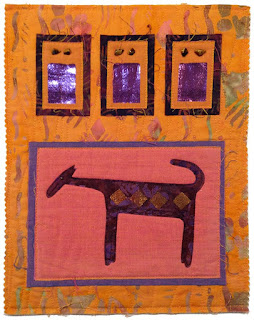There is nothing like the shimmer, glimmer, and sheen of real gold, silver, or copper leaf!
In my last post I showed you how to apply metallic foil to fabric a number of different ways. Today I'm going to show you how to apply metal leafing to fabric. Metal leaf, available as gold, silver, and copper, is an extremely thin sheet of real or imitation metal - for example, most silver leaf is actually made of aluminum, which, unlike real silver, never tarnishes.
 |
Store the fragile metal leaf in the original packaging to protect it.
Metal leaf is available in art supply stores and many craft supply stores. |
Supplies:
- Metal leaf
- Gel medium
- Paintbrush for applying gel medium (I use a small foam brush)
- A soft, full paintbrush for removing excess leaf
- Parchment paper
- Iron and ironing board
- Fabric
- Optional: freezer paper to create a stencil or mask, a commercial or original stamp
 |
Although metal leaf is applied to other surfaces with a special glue,
gel medium is the ideal adhesive for applying the leaf to fabric.
It's archival, flexible, has no odor, and is simple to apply. |
 |
For this demonstration I'm using a stamp block that I created for printing
with acrylic and adhesive foam, a soft brush, and a small foam brush. |
Instructions:
1. Using the foam brush, apply an even coat of gel medium to the stamp. Press it onto the fabric.
 |
| Apply even, firm pressure to the stamp for a good impression. |
2. Immediately lay one sheet of metal leaf carefully on top of the wet impression. Tap it into place. Use the separator sheets between the leafs to transport it to the fabric to prevent it from crumbling or breaking apart. Metal leaf is EXTREMELY fragile and must be supported as it's moved.
 |
Don't be concerned about small tears or breaks in the leaf, just be
certain to cover the entire surface of the wet impression. |
3. Wait 10 minutes for the gel medium to dry and then cover the leaf and fabric with a piece of parchment paper. Press firmly with a hot iron.
 |
| The parchment paper protects the iron from excess gel medium |
4. Allow the fabric to cool completely - approximately five minutes.
 |
| The gel medium acts as an adhesive to hold the leaf to the fabric |
5. With a soft brush, begin brushing away the excess leaf. The areas where the gel medium was applied will not be affected by the brush.
 |
| Save the small bits of excess leaf in a container for another project |
6. The final result. The beauty of leafing is that it is "perfectly imperfect" - there are variations in the edges, in areas that don't take the leaf as well, etc.
 |
Depending on the texture of the fabric, the weave may come through
the leafing, enhancing the final result. |
Variations:
- Create a stencil or mask with freezer paper. Iron the freezer paper to the fabric. Apply gel medium to the openings of this stencil or mask. Peel off the freezer paper and immediately apply the leafing to the fresh, wet medium. Allow to dry, cover with parchment paper, and press well with a hot iron. Brush any excess leaf away after the fabric has cooled completely.
- Apply gel medium freehand with a paintbrush. Add leafing sheets to the fresh, wet medium. Allow to dry, cover with parchment paper, and press well with a hot iron. Brush any excess leaf away after the fabric has cooled completely.
- Mix different colors of metal leaf to the same project.
- Apply the leftover small bits of metal leaf to wet medium for a multicolored, textured effect.
Note: Fabric that has had metal leafing applied to it can not be washed without damaging the leafing. This makes metal leafing ideal for art projects and not practical for functional projects.
Please leave a comment if you would like to win a package of metallic foil. Tell me how you would use metal leafing in your work, or how you might already have used it!
~ Jane Davila





























